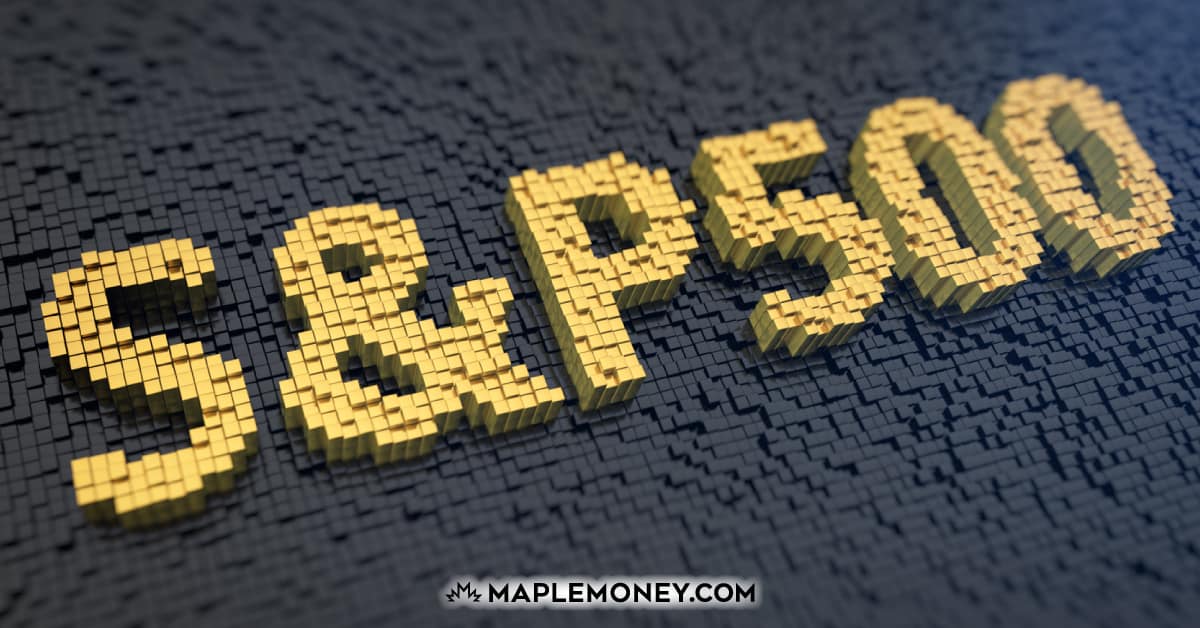The Best S&P 500 ETFs in Canada for 2022

In recent years, many Canadian investors have sought to profit from the U.S. stock market by gobbling up shares of tech darlings such as Tesla, Meta (Facebook), and Alphabet (Google).
After all, what could go wrong? What they discovered the hard way is just how volatile the tech sector can be, especially when you factor in historic global inflation and a war that has rattled the foundations of society.
Thankfully, there is a more reasonable way to invest in the U.S. stock market – through exchange-traded funds that track the S&P 500 stock market index. These low-cost equity investments provide less volatility with broad exposure to all sectors of the U.S. economy.
But you don’t have to purchase US-listed ETFs; you can choose between several S&P 500 ETFs from Canadian investment firms without exchanging your Canadian currency for U.S. dollars.
Best S&P 500 ETFs
You can buy the following S&P ETFs in Canadian dollars. The first ETF on our list invests in the total U.S. market, with more than 3600 holdings, including S&P 500 stocks. I’ve also included an ETF (VSP) hedged to the Canadian dollar. Let’s take a more detailed look at what each fund has to offer:
- iShares Core S&P 500 Index ETF (XUS)
- Vanguard S&P 500 Index ETF (VFV)
- BMO S&P 500 Index ETF (ZSP)
- iShares Core S&P U.S. Total Market Index ETF (XUU)
- Vanguard S&P 500 Index ETF (CAD-hedged) (VSP)
1. iShares Core S&P 500 Index ETF
Ticker: XUS
MER: 0.10
# of Holdings: 504
AUM: $4.8B
What We Like: Since inception (15.41%), performance has exceeded the benchmark.
The iShares Core S&P 500 Index ETF is meant to provide investors with long-term capital growth by replicating the performance of the S&P 500, net of expenses. There is a CAD-Hedged version of the fund, XSP, for those looking to mitigate currency risk. Unlike XUU, which holds mid and small-cap stocks, XUS invests exclusively in the S&P 500. It’s a large fund, with almost $5 billion in assets under management.
2. Vanguard S&P 500 Index ETF
Ticker: VFV
MER: .08%
# of Holdings: 507
AUM: $6.19B
What We Like: Large fund that provides access to the largest U.S. companies; low MER.
VFV is an excellent choice if your objective is to own the largest companies in the U.S. inside an ETF. The Management Expense Ratio (MER) is only .08%, and you get unhedged exposure to more than 500 US companies with a high market capitalization (large-cap). There is a hedged version of the fund further down our list, VSP, but it has not performed as well as VFV.
3. BMO S&P 500 Index ETF
Ticker: ZSP
MER: .09%
# of Holdings: 503
AUM: $9.1B
What We Like: Let’s you own large-cap U.S. stocks through a Canadian bank ETF.
ZSP is similar to VFV, with a slightly higher MER and almost identical performance over the past five years. However, over ten years, VFV has performed slightly better. ZSP is the larger of the two, with assets under management of $9.1 billion.
4. iShares Core S&P U.S. Total Market Index ETF
Ticker: XUU
MER: .07%
# of Holdings: 3650
AUM: $2.0B
What We Like: With over 3600 underlying stocks, XUU is the easiest and cheapest way to invest in the total U.S. stock market.
Okay, so XUU isn’t technically an S&P 500 ETF. It’s a total market ETF, which means it holds every stock in the S&P, not just the 500 largest companies. But I’ve included it on the list because many investors want access to mid and small-cap companies too, and this is an easy way for Canadian investors to get that total market exposure. I like the low MER (.07%).
Best CAD-hedged US Index ETF
5. Vanguard S&P 500 Index ETF (CAD-hedged)
Ticker: VSP
MER: .09%
# of Holdings: 505
AUM: $1.9B
What We Like: Exposure to the S&P 500 without the currency risk.
The Vanguard S&P 500 Index ETF is similar to VFV, except it uses derivative instruments to provide currency-hedged exposure to the S&P 500. Our top pick for shorter-term investors who want less exposure to currency risk. At .09%, MER is the same as VFV, although the returns have not been quite as high.
The Currency Question: Should I Buy Hedge or Non-Hedge ETFs?
When purchasing an S&P 500 ETF, Canadian investors need to consider that their returns can be impacted by currency volatility. That’s because the Canadian dollar ETF must convert to U.S. dollars to purchase the underlying US-listed ETF. If the Canadian dollar appreciates while you own the investment, your overall performance may be negatively impacted. If the U.S. dollar appreciates vs. the CAD, your total return may be greater than the underlying ETF.
Fund companies have created ETF versions that are hedged to the Canadian dollar to limit the impact of currency fluctuations. They do this by purchasing future derivatives and locking in a CAD-US exchange rate every month.
If you have a long-investment time frame, you’ll likely be better off going with a non-hedged ETF, because the currency risk is reduced over time. A CAD-hedged ETF may be the better option if your time frame is shorter. Before you decide on hedging, you should consult with an investment professional who can advise you on your situation.
Where Can I Buy ETFs?
The best way to add an S&P 500 Canadian ETF to your portfolio is with a trading account from an online brokerage. Online brokers allow you to hold various investments, including stocks and ETFs, in a single account, and you can trade from the comfort of your living room. Because everything is online, the trading fees are very low.
If you don’t already have a brokerage account, you can choose from at least a dozen. All big banks have their own brokerage accounts, and there are several low-cost, independent brokers.
When it comes to ETFs, your best bet is Questrade, because all ETF purchases are commission-free. Most brokers charge up to $9.95 every time you want to buy units of an ETF. The costs can add up, especially if you’re purchasing new units bi-weekly or monthly. If you open an account with Questrade using my exclusive link below, you’ll receive $50 in free trades. You won’t need it for the ETFs, but you may want to purchase a few individual stocks from time to time.
Open a Questrade Account Today and Get $50 in Free Trades
Another broker, QTrade, offers commission-free ETFs, but it’s limited to 105 funds. Lastly, Wealthsimple Trade offers free ETF purchases. It’s a mobile-only trading platform suitable to beginners, but it lacks the desktop trading and market research tools you get with Questrade.
Best S&P 500 ETF FAQs
What is the cheapest S&P 500 ETF?
The fund on our list with the lowest MER is the iShares Core S&P U.S. Total Market Index ETF (XUU). It has an annual MER of .07%.
Which S&P 500 ETF has the highest return over the previous five years?
From our list, ZSP edges out VFV, with an average annual return of 12.74% over the previous 5 years. VFV was a close second, at 12.73%.
Is it better to own ETFs or stocks?
There are advantages to owning both ETFs and individual stocks. ETFs allow you to own a diversified portfolio without investing large sums of money. Individual stocks have the potential to outperform ETFs if managed correctly, partly because there are no management fees associated with individual stocks. That said, you should have large sums to invest, along with substantial investment knowledge, to invest in individual stocks
Do ETFs pay dividends?
Yes. If an ETF earns dividends on its underlying securities, it must pay out the income to unit holders as dividends.
ETFs or Mutual Funds?
While we’ve compared different S&P ETFs in this article, you may wonder about a different option: U.S. Equity mutual funds. Does it make sense to purchase a mutual fund in Canada that tracks the s&P 500, or stick with an exchange-traded fund, like the ones covered in this article?
While mutual funds and ETFs are different, so it’s not a pure apples-to-apples comparison, the choice should be clear. A typical U.S. Equity mutual fund charges much higher fees with inferior performance vs. a comparable ETF.
For example, let’s compare the RBC US Index Fund (RBF557) to the #2 investment fund on our list, Vanguard’s S&P 500 Index ETF (VFV).
RBC US Index Fund Vanguard S&P 500 Index ETF
Benchmark S&P 500 S&P 500
Net Asset Value (NAV) $33.41 $95.53
MER(%) 0.50% 0.08%
AUM $1.9B $6.19B
5 & 10-year performance 10.9%/15.7% 12.73%/16.38%
As you can see, the RBC fund’s MER is over 625% more expensive than VFV. Both funds track the S&P 500 index, but VFV has delivered superior performance over 5 and 10 years, partly due to its low fees. Over an extended period, the difference in performance could be tens of thousands of dollars, depending on how much you have invested. Both funds are considered medium-risk.
Final Thoughts on the Best S&P 500 ETFs in Canada
If you’re building an ETF portfolio long-term, you need exposure outside Canada. Regular Canadian ETFs only give you exposure to Canadian companies. While you should consider several international markets (Europe, Asia), the U.S. is the first place to diversify your portfolio. It is, after all, the world’s largest market. If your goal is to hold the largest U.S. companies, you can’t go wrong choosing the first three ETFs on our list. For currency hedging, VSP is a logical choice. And if you decide that you want to own the total U.S. stock market, iShares XUU has you covered. The best part about S&P ETFs? The low fees, of course.

